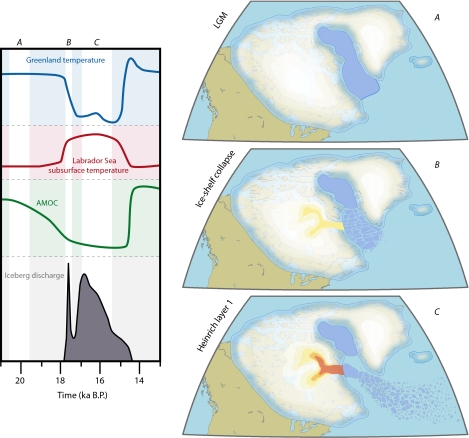Although the classic interpretation of Heinrich events being produced by internal Laurentide ice-sheet oscillations (1) had some deficiencies, its simplicity permitted it to survive 2 decades. However, recent articles finally shed light on the mystery of how Heinrich events are triggered. In PNAS, Marcott et al. (2) reported Mg/Ca data from the northwest Atlantic Ocean revealing an AMOC (Atlantic meridional overturning circulation) slowdown accompanied by a large subsurface warming that occurred more than 1,000 years before Heinrich events. The crux, indeed, resided in the subsurface of the ocean. Thanks to recent observations around Antarctica, the poorly understood coupled effects between ocean and ice-sheet dynamics have been revealed to be crucial for understanding past massive iceberg purges. In this way, the observed control that a warming ocean exerts on the ice-streams regime (3), combined with the confirmed anticipation of an AMOC slowdown (4) and a large subsurface warming (2), clearly indicates a climatic precursor for Heinrich events. The scenario can thus be summarized as follows (Fig. 1 illustrates the mechanism specifically for Heinrich event 1):
Fig. 1.
Schematics of the Heinrich event 1. Left: Time series illustrate the evolution of the main variables involved with the triggering mechanism. A, B, and C indicate critical steps in the Laurentide ice sheet around Heinrich event 1. Right: Warm colors in B and C represent acceleration and thinning in ice streams of the Hudson Bay and Hudson Strait area.
A change in the mode of oceanic circulation favors a reduction in North Atlantic Deep Water formation and an AMOC slowdown. With reduced convection, the subsurface oceanic layer progressively warms, increasing the rate of basal melting under the Labrador Sea ice shelf.
Once the depth of crevasses in the ice shelf represents a high proportion of the thinning ice shelf, this latter abruptly collapses. A first very pronounced peak in calving is produced.
The missing buttressing effect previously exerted by the ice shelf favors a strong ice-stream acceleration, thus transporting inland-ice and detritus into the Atlantic that translate (i) into a sea-level rise of up to 2 m and (ii) into the Heinrich layer observed in marine sediments.
These two latter points have recently been simulated in an ice-sheet/ice-shelf model (5), definitely confirming the triggering mechanism exposed by Marcott et al. (2). Therefore, in the current year, thanks to interdisciplinary and independent work covered by different teams around the globe, the intriguing issue of how Heinrich events were triggered has seen notable advancement.
These phenomena and mechanisms are, moreover, highly relevant to the physics required for accurate sea-level rise predictions, especially if the Ronne and Ross ice shelves around Antarctica are threatened by a warming ocean resulting from current climate change.
Acknowledgments
We thank A. Robinson and E. E. Lucio-Eceiza for comments, helpful discussions, and artistic assistance. This work was performed under the Spanish program of the International Campus of Excellence.
Footnotes
The authors declare no conflict of interest.
References
- 1.MacAyeal DR. Binge/purge oscillations of the Laurentide ice sheet as a cause of the North Atlantic's Heinrich events. Paleoceanography. 1993;8:775–784. [Google Scholar]
- 2.Marcott SA, et al. Ice-shelf collapse from subsurface warming as a trigger for Heinrich events. Proc Natl Acad Sci USA. 2011;108:13415–13419. doi: 10.1073/pnas.1104772108. [DOI] [PMC free article] [PubMed] [Google Scholar]
- 3.Jacobs SS, Jenkins A, Giulivi CF, Dutrieux P. Stronger ocean circulation and increased melting under Pine Island Glacier ice shelf. Nat Geosci. 2011;4:519–523. [Google Scholar]
- 4.Gutjahr M, Lippold J. Early arrival of Southern Source Water in the deep North Atlantic prior to Heinrich event 2. Paleoceanography. 2011;26:PA2101. [Google Scholar]
- 5.Alvarez-Solas J, et al. Heinrich event 1: An example of dynamical ice-sheet reaction to oceanic changes. Clim Past Discuss. 2011;7:1567–1583. [Google Scholar]



